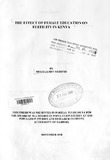| dc.contributor.author | Mugo, James M | |
| dc.date.accessioned | 2013-05-09T12:12:27Z | |
| dc.date.issued | 1998 | |
| dc.identifier.citation | Master of Arts | en |
| dc.identifier.uri | http://erepository.uonbi.ac.ke:8080/xmlui/handle/123456789/20850 | |
| dc.description.abstract | There had been at first some reluctance to accept the reality of fertility decline in Kenya
until the early 1980's when the country a record fertility decline of more than 20%.
This decline whose evidence has been shown from more sophisticated cohort analysis
and comparison between two or more surveys exceeded by far the 10% decline that
has come to be conventionally accepted as indicating the onset of irreversible fertility
transition. With this acknowledgement there is need now more than at any other time
before to undertake ever intensified more focused studies aimed at isolating the key
determinants of fertility which can be used for the formulation and implementation of
appropriate population policies in the country.
This is one of the chief aims of this study which aimed at investigating the effects of
changing levels of formal education among women (female education) among other
social-economic and demographic factors on the key proximate determinants of fertility
amongst Kenyan women.
The unit of analysis in this study was individual woman while the fertility measurement
is children ever born (CEB). A micro-level analysis was chosen because it offers a
better chance of gaining greater insights on the likely impact of female education on
fertility by overcoming some of the shortcomings encountered in macro-level analysis
type of studies.
The study utilised the 1993 KDH~data a National Survey that utilised a woman's
questionnaire to collect data on the women's characteristics. To analyze the data,
Linear Regression and Correlation methods of statistical analysis were used i.e.
cross-tabulations, simple linear regression and multiple regression with the aid of the
SPSS computer package.
The general findings of the study shows that female education is negatively related to
fertility. The most significant finding and possibly the contribution of this study is that
education influences fertility largely by interfering with or altering the demographic
characteristics of the individual woman.
The study is organised in four chapters. Chapter One deals with the introduction to the
study as well a~ the definition or isolation of the study problem. It includes the
introduction and background to the study, statement of the problem, objectives of the
study, scope and limitations of th-e. study as well as the justification of the study.
Chapter Two deals with the presentation ofliterature readings on findings from earlier
studies in the same field. It also presents the relevant theoretical framework adopted
for the analytical purposes in this study as well as the explanation of it's
iv
operationalization which includes the statement of the operational hypotheses both
diagrammatically and formally.
Chapter Three focuses on data and methodologies used for analysis. It examines the
source and quality of data as well as the statistical methods used to study the
interrelationships between fertility and its determinants.
Chapter Four deals with the statistical analysis of data and the results. The relationship
of fertility (CEB) with Education alongside some selected social-economic and
demographic variables through the selected proximate determinants is examined and
the results as well as the explanations for them given.
Chapter Five deals with the summary conclusion and recommendations. To begin with
a small summary of the major findings is given followed by the conclusion of the study.
Female education is central to fertility decline such that no fertility reducing models and
policies can afford to ignore it. Lastly recommendations based upon the foundations of
the study are postulated and put forth aimed at both the policy makers and future
researchers. | en |
| dc.description.sponsorship | University of Nairobi | en |
| dc.language.iso | en | en |
| dc.publisher | University of Nairobi | en |
| dc.subject | Female education | en |
| dc.subject | Fertility | en |
| dc.subject | Kenya | en |
| dc.title | The Effect of Female Education on Fertility in Kenya | en |
| dc.type | Thesis | en |
| local.publisher | Faculty of Arts, University of Nairobi,Kenya | en |

